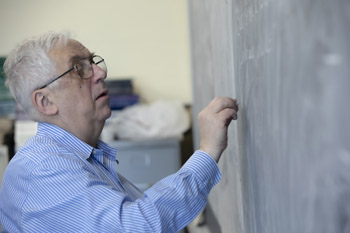
The Abel Prize 2020
The Abel Prize 2020 has been awarded to Hillel Furstenberg and Gregory Margulis "for pioneering the use of methods from probability and dynamics in group theory, number theory and combinatorics". The prize, which has been awarded since 2003, is one of the highest honours in maths and carries a prize money of around $400,000.
As is often the case with prizes awarded for mathematical achievements, the winners are being honoured, not for work in one particular area of maths, but for finding surprising connections between several areas. "Part of the beauty of mathematics is way that ideas from different fields come together," said Furstenberg when he was interviewed by Alex Bellos on award of the prize. "There must be something behind all this, some greater harmony to which these things belong. The aspect of the beauty of mathematics is what has been attracting me to the subject and seems to be guiding me in some sense."
Random walking

Hillel Furstenberg. Photo: Yosef Adest, Hebrew University of Jerusalem.
It's impossible to give a complete overview of Furstenberg and Margulis' work, so we will try and give a little flavour of some of the ideas. We usually think of probability theory as coming into play when things are random: when a die is being cast or lottery numbers are drawn. Many processes in nature are random too. When a dust particle floats through the air or a dog sniffs out its favourite patch of park, their trajectories seem to randomly change direction, unguided by any discernible rule or law.
This kind of motion can be represented by what mathematicians call a random walk: a sequence of steps where each step goes into a random direction. Random walks are good for modelling random processes, such as the motion of dust particles or of stock prices. But when it comes to moving around, you might think that random walking isn't a very useful thing to do — and it definitely isn't if you want to go from point A to point B as fast as possible. However, it turns out that randomness is a good strategy for exploring or searching. A dog, randomly sniffing out a patch of park, is likely to find a hidden treat quicker than one using a systematic search strategy. If you have just arrived at your holiday destination and set out to explore your new surroundings, you might equally choose to randomly walk around town to see what you might find.
Indeed, random walks can tell you things about the space you are walking around in. If, while randomly walking around a town, you quickly return to your starting point, you will feel tempted to conclude that the town isn't very large. A random walk and the length of time it takes on average to return to where it was before, can therefore be used to measure the size of things. Interestingly, this also works when that size is infinite. If you are walking around an infinitely large city, then as long as you have an infinite amount of time, you can be sure that a random walk will eventually take you back to where you started: the chance of that happening is 100%. If, however, your infinite town were laid out in three dimensions and you could walk on air, so that you could randomly move in all directions, including up or down, then the chance of returning to your starting point would only be around 34%. The chance of your walk recurring depends on the type of space you are walking around in. (You can find the maths behind these chances in this article published alongside this year's Abel Prize announcement.)

Gregory Margulis. Photo: Dan Rezetti.
Similar ideas of chance and trajectories are also important when you are looking at dynamical systems, even ones that aren't random. Imagine, for example, a billiard ball moving around on a billiard table without friction: the ball will move around forever, changing direction whenever it bounces off a wall. There's nothing random about this, in theory we can calculate exactly where the ball will be in ten years' time as long as we know the direction it started moving in. However, we'd need a crazy amount of time to do this and in general the ball's trajectory will be chaotic: even the smallest mistake in our calculation will snow-ball so that the answer turns out to be completely wrong.
Luckily, though, the trajectory of the ball is likely to be ergodic: it will visit each part of the table in equal measure. A mathematical result called the Birkhoff ergodic theorem tells you that if a system is ergodic, then even though you can't predict precisely what it will do in the future, you can accurately predict average quantities for typical trajectories. So while you might not be able to predict exactly where a ball will be after some time has elapsed, you can accurately predict what proportion of its time it spends in a certain region of the table. (You can find out more about the maths of billiards here.) The theorem works for other dynamical systems too. If, for example you are looking at a gas in a container, you won't be able to say exactly where its many constituent molecules are at any given moment, but you can predict quantities that depend on the bulk behaviour of the molecules, such as its temperature or pressure.
Numbers and symmetries
What these examples illustrate is that random walks can help you explore spaces, and probabilities can give you insights about complex things that themselves aren't random at all. This can work even when the spaces or systems involved are mathematical constructs. In this spirit, Furstenberg and Margulis applied insights involving random walks and ergodic theory in a range of other mathematical disciplines, with rich rewards.
For example, a celebrated result in number theory, proved by Ben Green and Terence Tao, is that within the prime numbers there are arbitrary long arithmetic progressions: sequences of primes that are a fixed distance away from each other. A very short arithmetic progression is 3, 5, 7. Here, the distance is 2 and the length of the progression is 3. What Green and Tao proved is that, if you look hard enough, you can find an arithmetic progression of prime numbers of any length you like, be that 2 or 2,000,000. Green and Tao's proof used an insight by Furstenberg, based on probabilistic ideas, which Furstenberg had previously used to give an alternative proof of a theorem by another Abel laureate, Endre Szemerédi (you can find out more here and here).

This intricate diagram describes some of the structure of a Lie group called E8 (find out more here). It was generated on a computer by John Stembridge, based on a hand drawing by Peter McMullen. The image was taken from the website of the American Institute of Mathematics.
Another example of the laureates' work starts with one of the nicest and simplest objects in maths — the circle — but quickly leads into tricky mathematical territory. One of the nicest things about the circle is that it is so symmetrical. For example, you can rotate it around its centre point through any angle you like without changing its appearance. This isn't true of the square, which you can only rotate through multiples of 90 degrees without changing its appearance. The collection of rotational symmetries of the circle has infinitely many members, while that of the square has only finitely many members. What is more, the collection of rotational symmetries of the circle is continuous: whatever number you pick on the continuous number line, the rotation through the angle given by that number is a symmetry of the circle. For the square, this isn't the case: only a finite collection of discrete numbers on the number line would give you a rotation symmetry.
The collection of rotational symmetries of the circle is an example of a Lie group, named after the Norwegian mathematician Sophus Lie, who worked on them in the 19th century. Lie was actually interested in certain types of equations, called differential equations, and ended up in the land of symmetries because the solutions of such equations can exhibit a certain type of symmetry (you can find out more about the symmetries of polynomial equations in this article).
Generally Lie groups, continuous collections of symmetries, are complex beasts, which mathematicians very much like to understand, not least because they are linked to solutions of equations. Margulis and Furstenberg made significant contributions to our understanding of Lie groups, exploring them using random walks and probabilistic insights. Margulis was even awarded a 1978 Fields medal, the other high honour in maths beside the Able Prize, for his early work on Lie groups.
The ideas presented here are just a tiny superficial scratch on the surface of Furstenberg and Margulis' bodies of works. Interestingly, the two never worked together directly, indeed Margulis did much of his early work isolated from the rest of world behind the iron curtain. Yet, they two influenced each other and displayed an equal brilliance of mind.
As Arne B. Sletsjøe put it in an article published alongside the announcement of the prize, "The mathematical garden has many hidden treats, the work of this year's Abel Prize laureates suggests that random walk could be a good strategy to reveal some of them."
There is more interesting information about the laureates and their work, including a video of the prize announcement, on the Abel Prize website.